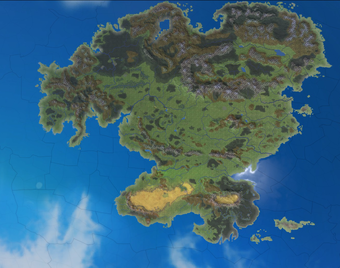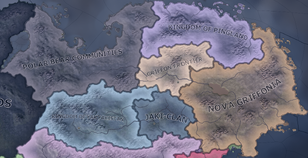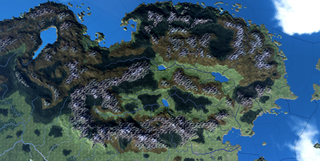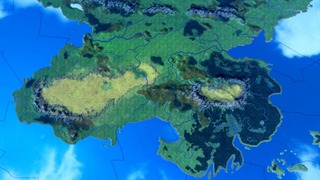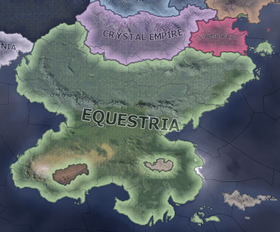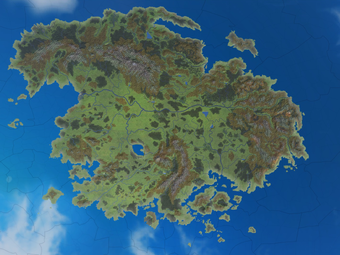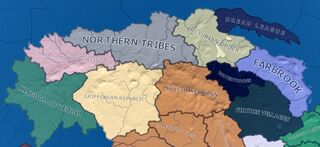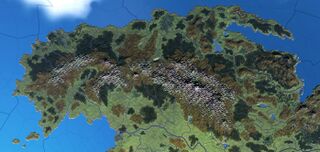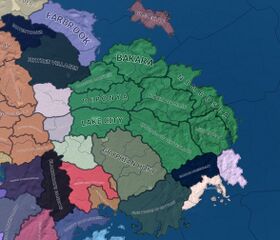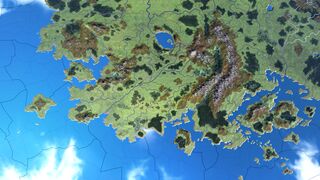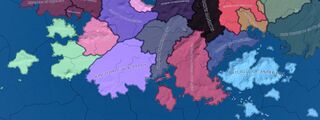World Map and Geography
Equus
Northern Equus
The frigid and mountainous north of Equus is an inhospitable landscape, but hardy races have lived there for a long time. Changelings, yaks, polar bears and penguins have adapted to the cold temperatures, yet more recently waves of griffon settlers arrived in the region. Legends also say how ponies once lived here, back when the climate was warmer, but now only ruins remain after all the ponies migrated south.
The changelings are the most formidable race in the north, living under the strong leadership of Queen Chrysalis. The yaks were until recently united in the isolationist kingdom of Yakyakistan, but as Equestrian influence continued to grow in the region, the more conservative yaks of the Jaki-Clan rebelled. A brutal war followed, but neither side was able to overcome the other so a temporary peace treaty was signed. Further north, there are the Polar Bear Communities which were founded only some years before. Polar bears are used to being divided, so only time will tell if the newborn nation can survive for long. On the northeastern shores, the venerable Kingdom of Pingland is facing a succession crisis as their old king is at death's door. South of them is the industrialized griffon colony of Nova Griffonia, left stranded as their colonial overlords in the east have utterly collapsed. Now the independent griffons must determine their role on the world stage and learn to live by themselves. Meanwhile their small autonomous territory, the Griffon Frontier, is far too busy dealing with bandits and worse. Without Nova Griffonia's support, they will likely collapse.
The changelings have great ambitions, seeing Equestria as decadent and weak and themselves as the rightful rulers of all Equus. The yaks fight amongst themselves, the polar bears and penguins continue to develop into proper states, while Nova Griffonia prospers. The future is full of possibilities for the northern nations, but also full of danger. What will the changelings do? And will the other races of the north band together or tear each other into shreds?
Southern Equus
The area of southern Equus is vast, and there is a huge variety of climate and terrain, ranging from the cold marshes of the north to the hot deserts of the south. One race dominates the region above all: Ponies. However, there are also deer, buffalo, dragons and griffons. The ponies live on flat plains, arid drylands and sparse woodlands, the home of the deer is in boreal forests, tall mountains and swamps, while buffalo and dragons live in small nations under the shadow of their gigantic neighbour.
Equestria is by far the largest and most industrialized nation in the world, regarded as the haven of ponykind. Under principles of harmony, they have remained peaceful and prosperous for a millenium. Other pony nations on Equus are Crystal Empire, a close ally of Equestria which recently broke free from King Sombra's curse, Stalliongrad, a breakaway Equestrian province and the cradle of communism, as well as tiny Starlight Town, a city-state which is recovering from the rule of a mad cult. In the northwest, the deer live under the rule of the Kingdom of Olenia and its corrupt King. Aside from these larger countries, there are the small Buffalo Chiefdom, a tribal enclave within Equestria, as well as the United Dragon Tribes, which recently had a pro-Equestrian ruler come to power.
Southern Equus used to be peaceful, but recent times have changed that. Stalliongrad revolted, Changeling Lands attempted to seize control of Equestria, and Olenia had a dramatic change of rulership. Now tensions remain high between the major nations. The changelings of the north are building up for war while their rivals seem ill-prepared, as Olenia is weakened by internal instability and Equestria clings onto its pacifism. The smaller nations wait and watch, some of them deciding whose side to take in the upcoming conflict. Worse still, the major nations are among the most technologically advanced and industrialized nations in the world, so any wars between them would turn into carnage on an unprecedented scale. Some pray for tensions to dissipate and for peace to return, but as dark clouds gather, war seems inevitable.
Griffonia
Northern Griffonia
The cold lands of northern Griffonia have long been sparsely populated, as, unlike in northern Equus, arctic races did not settle the region. Instead, there were hardy griffons and ponies who migrated from the south and west, respectively. Griffons settled the marshy valleys south of the Whitetail Mountains, while ponies arrived from across the gulf to the frozen forests of the northern shores. Most kept going, trying to find a better place to settle, but some chose to stay and have adapted to the cold over the centuries.
These ponies are known as the Northern Tribes, and lived in isolation until griffon revolutionaries crossed the mountains and carved out their own nation in Skynavia. The Kingdom of Vedina has long stood independent, remaining autonomous during the Empire's reign, with its distance from the griffon heartland allowing its inhabitants to retain their traditions. To the east, the Duchy of Cloudbury fell after the remnants of the Griffonian Republic fled there. The revolutionaries now live in exile, hoping to one day return to Griffenheim. In the Whitetail Mountains themselves, there is the savage Sunstriker Clan, nominally loyal to the Empire but likely to break free when the opportunity presents itself. To the northeast lie the Arcturian Order and the Dread League, ancient foes stuck in the past due to their extreme isolation.
The griffons of the north were once subjects of the Empire, but became independent after it fell. If the Empire were to rise from its stupor, their newfound freedom would be at risk, and due to the poor and underdeveloped lands of the north, they have would little strength to resist its might. Out of all of them, the Griffonian Republic is the strongest, but alone they stand no chance. Beyond the mountains, Skynavia and the Northern Tribes are locked in bitter conflict as the ponies try to push out the invaders while the griffons try to spread the light of communism to the dark north. In the continent's darkest corner, the Dread League is gathering its strength to crush the Order once and for all. After that, nothing will stand in their way.
Central Griffonia
While the authority of the Griffonian Empire collapsed everywhere else, it still exists in central Griffonia, albeit in a greatly weakened form. It is here, in the fertile plains around the mighty Griffking River, where Emperor Grover I established his capital of Griffenheim, and where it has remained ever since. The region is densely populated by griffons, while diamond dogs inhabit the Bronze Mountains to the north. In the east, the magical Scheißwald forest has been a near insurmountable obstacle for griffon settlers for centuries, while the great Lake Rumare and the mountains of Blackhollow make up the southern boundary of the region.
After the Republican Revolution, the region became greatly fractured. In the Herzland, the Empire exists as a small rump state around Griffenheim, surrounded by nominal vassals who are part of the Reichspakt. Further south, the Duchy of Verenia has been torn asunder by civil war between rival houses. The Kingdom of Griffonstone, left without its greatest benefactor, is stranded. The small barony of Rumare now has a chance to save its dying culture, while Blackhollow in the east has been overrun by Blackrock's Bandits.
While the Empire is weak for now, it may yet recover its strength. Should that happen, the vassals are in danger of losing their autonomy, and most of them will refuse to give it up without a fight. Unfortunately, the Herzland can only be reunited through conflict. The same is not true for Verenia, where the civil war may yet find a peaceful solution. In the south, Rumare may seek to reclaim its historical lands from Griffonstone, while Blackrock has ambitions in the east - if she isn't overthrown. All of these states have to be wary if the Empire reunites the Herzland, for it may then seek to bring all the former Imperial lands back into the fold. Aquileia and Wingbardy, too, may seek to expand their influence in the region, thus possibly sowing the seeds for a conflict between them and the Empire. It is hard to predict the future, but one thing is certain: There will be blood.
Eastern Griffonia
The region of eastern Griffonia is defined less by strict geographical boundaries and more by the Griffonian Empire's historical lack of influence in the region. As such, it covers a large part of the Griffonian continent, and several races besides griffons live in these lands. Eastern Griffonia is traditionally divided into three sub-regions: the Evi Valley in the south, where griffons live along the Evi river and its many tributaries, the Riverlands, a mountainous region populated primarily by ponies, but also by diamond dogs and griffons, and lastly Beorgfordas, also known as Hill-land, home of the secluded hillponies. The source of the mighty Griffking river lies in the mountains of the Riverlands. From there, it flows westward, almost splitting the continent in two. Another notable feature in the region is the magical Eygsic Forest, rumoured to be home to giant spiders.
Overall, the nations of the region are less developed than those in the west, primarily due to how far away it is from Equestria and other advanced nations. Out of the three sub-regions, the Riverlands are the most developed. Here, seven pony nations and, more recently, Diamond Mountain, are united by a defensive alliance known as the River Coalition. In the western Riverlands, there are two griffon nations outside of the Coalition: Hellquill and Longsword, remnants of the grand crusades of Emperor Grover II. The southern coast of the Riverlands has three nations which sprung up after law and order deteriorated in the region, with a diverse populace of ponies, zebras, deer and griffons. The Evi Valley to the south is more backwards, with its griffons clinging strongly to their traditions. Some, however, want change, and already Brodfeld is engulfed in a brutal civil war against the communists of the Griffon Liberation Army. In the north, the hillponies have no such desire to embrace modernity. Their tribes are like a time capsule of a bygone age, with tribal chieftains holding to power under the protection of the River Coalition. Off the coast, there is the island of Greneclyf, home of changelings who, so far, have remained isolated from the outside world.
The collapse of the Empire brought many changes to the region. The main antagonist of the River Coalition is gone, and it must now redefine its identity. Some push for federalization while others want the Coalition to be a thing of the past. The Evi Valley broke free from the rule of the Empire, but suffers from instability. If reforms are not made soon, the backwards griffon nations will collapse in on themselves, and a red star will rise from the ashes of old. The hillpony nations are less oppressive, but some ponies push for the embracement of modernity regardless. The winds of change are blowing in the east, but none can yet say what kind of change they are bringing.
Southern Griffonia
The southern coast of Griffonia is the warmest part of the continent, with the southermost areas even sporting humid jungles. Otherwise, the landscape is dominated by arid plains and hills, with a few mountain ranges and many islands in the neighboring seas. It is populated primarily by griffons, but there are also a sizeable number of ponies in the west and minotaurs in the east, who live on numerous islands, the largest of which is Kainourgio Spiti. The northern boundary of the region is made up by Lake Rumare and the Blackhollow Mountains.
The ponies inhabit New Mareland, an overseas dominion of Equestria established by ambitious colonists, who bought the monster-infested land from the Duchy of Talouse centuries ago and cleared it for settlement. After the collapse of the Griffonian Empire, Talouse, alongside other minor nations in the region, joined the Karthinian Pact, led by the mighty Kingdom of Wingbardy. Falcor, their old rival, did not join, and was then devastated in a war against Wingbardy where they lost their capital. The parishes of Sicameon distrust the western and northern monarchies and are a beacon of liberty in the south, alongside the minotaurs of Asterion, their close allies, who seek to liberate their kin from the oppressive rule of Cyanolisia and its griffons.
Wingbardy is by far the strongest nation in the region and dominates its politics. However, they suffer from political and economic instability which may result in a radical change of government. Such a change will likely affect the entire region, not just the other Pact members. Meanwhile, New Mareland has so far remained loyal to Equestria, but the economic depression has made some ponies demand patriation and full independence. In the east, Asterion is preparing for war against Cyanolisia, and Sicameon is likely to support them. And while the nations of the south bicker, the Empire might rise in the north. Despite being so far away from Griffenheim, they may not escape the wrath of a resurgent Empire.
Western Griffonia
The Griffonian west has traditionally had closer ties to Equus due to its proximity. It has many natural harbours, and the interior is mostly hilly and densely forested, so population and development are concentrated near the coast. The majority of the populace consists of griffons, though the southwest has a significant pony minority that has integrated into local culture. Off the coast, there are the islands of Haukland which lie near major trans-continental trade routes.
For most of its history, the west was dominated by the Crown of Aquileia, albeit it was conquered by the Griffonian Empire and, after its collapse and independence, suffered from a republican revolution, counter-revolution and subsequent decentralization. Now, the Kingdom is divided into many parts, all nominally under the rule of the King. North of Aquileia is the Periphery, the frontier region of the Kingdom now ruled by many small statelets. To the northwest is the Skyfall Trade Federation, once the most prosperous part of the Empire, and now an independent nation and a naval powerhouse. The islands of Haukland are also independent, ruled by deserters, pirates and other outlaws.
Unlike in the Empire, Aquileia's revolutionaries did not flee, they hid. And now they are preparing to strike again and topple the monarchy for good. The King and his vassals are trying their best to crush the uprising before it even begins, but things are unlikely to go as planned. While Aquileia is busy with internal issues, the small nations of the Periphery seek to establish themselves as proper states while clashing with each other. Eventually, Aquileia will go north and seek to reclaim its former territory, so they must prepare. Skyfall remains relatively stable, but their leader is very old and likely to pass away soon, forcing a change in power. The Hauklanders do as Hauklanders please, with no one to intervene in their affairs. However, the heartland of the Griffonian Empire is close, and the old superpower may yet recover its strength. Should this happen, the Empire will likely turn its gaze to the rich lands of the west. Aquileia has long hated the Empire, but hate alone will do nothing if they do not prepare themselves for the storm.
Zebrica
Eastern Zebrica
The homeland of the kirin race, the region of Eastern Zebrica collectively known as Kiria, features many different landscapes, separated from the deer and llamas to the north by a tall and nearly impenetrable mountain range, and from the zebra nations to the west and south by the mighty Marekong river. In the north, the terrain is predominantly plains and hills, interspersed with significant swathes of dense forest. This region is controlled by the Realm of Kiria, the largest and most powerful kirin state. The area is home to two important river systems that make it hospitable and suitable for a thriving agricultural society. Foremost is the lifeblood of Kiria: the magnificent Great Mellifluve and its many tributaries, which connect the majority of the region together and provide for fertile farmland between the river's many branches. The Great Mellifluve empties into the South Kirin Sea after passing by Verdant, the trade city that connects the region to the lesser kirin nations in the south. The imperial capital of Vermilion sits along the easternmost branch of the Great Mellifluve, nestled safely in a fertile valley surrounded by mountains and hills that partially isolate and protect it from the surrounding countryside.
To the north lies the other, smaller, but just as vital, river system; the Carmine River terminates at the port city of Fragrance, once the primary trading hub of the entire realm, connecting the merchants and traders of the Realm of Kiria to the rest of Zebrica. Nowadays, the rivers are scarcely traveled, with most kirin returning to subsistence farming in the plains between the rivers, their once magnificent cities depopulated and declining, the infrastructure falling into disrepair. However, the region is rich in natural resources, land, and people, and the rivers make it a perfect candidate for industrialization, should The Silence ever end.
In the south of Kiria, three autonomous states split off from the Realm of Kiria when the Silence began. The nations of Sen Kinh, Lan Kir, and Khamrin are all predominated by dense jungles and forests, with far fewer resources and a much smaller population than their northern brethren. Their lands are underdeveloped and untamed, and it will take great effort to modernize the lower kirin lands to the same level as the north once was. Of these three nations, Sen Kinh fares the best, as the city of Blossom has remained a valuable trading port following the collapse of the trade routes in the north, and its lands are not as densely wooded as their two western neighbors. It will take effort and a strong leader, but perhaps there is a chance that these three southern kirin nations may one day unite and find themselves strong enough to withstand a resurgent northern Kiria.
Northern Zebrica
The sunny shores of northern Zebrica lie south of the equator, and thus its climate ranges from tropical to subtropical. The region is very hilly and has many islands, most notably Aris and Macawia. In the south, closer to the vast Zebhara desert, the region becomes more arid and inhospitable, but also less hilly.
The nations of northern Zebrica have close ties to Equus and Griffonia and thus are among the more advanced nations on the continent. This is especially true for the island nations of Hippogriffia and Macawia, but also the secluded realm of Chiropterra and the "republic" of Tobuck as well. Colthage, a venerable maritime republic, and Warzena, a monarchy ruled by a benevolent king, are still in the process of industrializing. Quaggatai, the realm of a Khan who took advantage of the chaos caused by the Storm King, and Zarantia, a federation of desert nomads, are underdeveloped, agrarian nations.
The coastal regions were the final victim of the Storm King's campaigns of pillaging and destruction, but Hippogriffia, Macawia and Chiropterra managed to survive unscathed. In fact, it was the hippogriffs who came out of hiding in Seaquestria and decisively defeated the Storm King. Macawia's powerful and modern fleet kept the islands safe, while the fortress-nation of Chiropterra was too heavily defended to be worth the effort. The rest of the region still has to recover from the devastation.
Chiropterra is the most likely to take advantage of the weakness and disarray. However, what they do depends entirely on what happens in Equestria. If their plans fail, then they are likely to take an aggressive stance and pose a major threat to the smaller nations. Colthage, despite suffering from internal instability, may choose to ally with them against Hippogriffia. As a bulwark of harmony, Hippogriffia will have to face them, but they might have to deal with internal threats first. Macawia will not intervene in this conflict and in general has little interest in mainland affairs.
Northeastern Zebrica
There is much variety in the geography of northeastern Zebrica. There are the snow-covered Andelayas which are the tallest mountains in the world, the arid highlands where the llama and alpaca dwell, and the humid jungle valleys and marshes of Hindia, home of the Hindian deer and their Olenian overlords. The sheer size and magnitude of the Andelayas has prevented any invasion by land, keeping Hindia safe and secluded from the rest of the continent. But the mighty mountains could do nothing to keep the region safe from seaborne invaders, whose longships carried them from across the vast eastern ocean.
Due to this separation, much of the northeast is underdeveloped. The llama and alpacas of the highlands live in splendid isolation, ruled by an absolute and divine monarch, the Sapa Llama. The state controls almost everything, and wants to make sure nothing changes the status quo. On the slopes of the mountains, there is the small realm of Stagpal, carved out by an ambitious deer conqueror, yet is populated mostly by llamas and alpacas. Down below, Hindia is divided between four nations: Chital and Sambar, whose Yarils are successors of Olenian vikings who conquered much of the subcontinent many centuries ago, as well as Doelhi and Barasingha, the principalities of the native deer. Off the shore, there is also the island realm of Uusi Hirvimaa. Once the center of Olenian rule on the subcontinent, it is now a subjugated Macawian protectorate.
The region was spared from the Storm King's wrath mostly because of how far away from the yeti homeland it is, but the mountains also formed a great barrier against his airships. Yet even then, the region suffers from widespread poverty and illiteracy which hinder progress and weigh down on its nations. The one economic boon the region has is its many rubber plantations, meaning a united Hindia could become one of the world's leading producers of rubber.
A united Hindia, however, seems like a pipedream in 1007. Tensions between the two groups, the heirs of viking conquerors and the native princes, continue to grow, while the Yarildoms and the principalities suffer from internal instability as well. A peaceful solution seems unlikely, and a region-wide conflict seems inevitable. Perhaps in the end, after the dust has settled, the deer of Hindia may have united under one banner.
Central Zebrica
The center of the Zebrican continent is dominated almost entirely by the humongous Zebhara Desert, the largest of its kind in the world. The desert itself is very inhospitable and is sparsely populated, primarily by zebras and camels who live on scattered oases and endorheic rivers. The outskirts of this wasteland are more habitable: the foothills of the Andelayas in the east, and the Great Lakes in the west, fed by the mighty Neighle river.
The desert itself is desolate and is populated mostly by nomadic tribes. The northern part of the Zebhara is nominally controlled by the Azir tribes, while the south is under the rule of the Central Zebrican Empire and its mad yeti warlord. In the east, the Free Camel Tribes resist the rule of another yeti warlord, the self-proclaimed King Boltrus of Boltria who seized Camelkand and now rules most of camelkind. In the west, around the Great Lakes and along the Neighle river, exist many small zebra kingdoms and warlord states, formed after the fall of the Mazwi Empire. The entire region is a powderkeg ready to explode, as most of the countries only recently declared independence, and some want to replace Mazwi as the new hegemon of the Great Lakes. The small nation of Re'em, ruled by a religious sect of horses, do not want to get directly involved in the upcoming conflict, but might support some of the warlords.
Central Zebrica was already poorer and less developed than the northern and western parts of the continent, but the Storm King made things much worse. The large and prosperous Mazwi Empire was sacked and destroyed, now only existing as a small rump state surrounded by furious former subjects. Further east, ambitious yeti generals established realms of their own after the Storm King's death and now rule as cruel despots. Much of the wealth in the region was looted and carried elsewhere, yet the region cannot recover until numerous existing tensions are resolved.
The Great Lakes are likely to reunite, but which kingdom, tribe or warlord does so is difficult to predict. The Central Zebrican Empire will likely collapse as soon as the mad emperor dies, while the camels will fight for their freedom or die trying. There is great potential in the region, but for any of it to be realized, much blood will need to be spilled.
Southern Zebrica
The southern coast of Zebrica has many frozen mountains, whose glaciers are the source of the mightly Neighle river, while the valleys and plains below are covered by boreal forests. The high altitude and proximity to the south pole results in a climate that ranges from temperate to subarctic. Many races live here: Zebras, hyenas, yeti, gargoyles, and centaurs. In the past, most of the races managed to live together in relative peace, but after the Storm King united the squabbling yeti race under one banner, everything changed.
But the Storm King is now dead, and the heartland of the kingdom he created is divided between four warlords, each claiming to be his true heir. While they are distracted, other races try to recover from the devastation wrought by the yeti. The Qaylidi Dervishes are a remnant of the fallen Kingdom of Hyenia, led by spiritual warriors who are preparing to liberate their homeland. In the east, the ancient alliance between Gargiloya and Senturya prevails for now, but none can tell how long it will last. In the northwest, the zebras of Hayzeb who are free from yeti influence focus their attention on the power struggle in the Great Lakes, but there is no doubt they will eventually shift their attention south and try to free their oppressed brethren.
The south suffered the most from the Storm King's campaigns. Many countries were completely destroyed and annexed directly into the Storm King's domain, while others were looted and ravaged. However, the yeti homeland itself has prospered, becoming rich from all the loot brought back by yeti warriors. But now as civil war tears the south apart, even that prosperity is threatened. Whoever wins and claims the mantle of Storm King will have to spend a long time to rebuild.
While the yeti focus on their civil war, the Dervishes will intervene and try to reclaim their homeland. The Hayzeb Federation will primarily focus on the Great Lakes, but intervention is not out of the question for them either. Further east, the gargoyles and centaurs will deal with internal affairs, trying to keep their alliance and their countries together. But once the civil war ends, no one wants the brutal campaign of the Storm King to be repeated, and an anti-yeti alliance seems inevitable. The many races of the south yearn for peace, but there will be none until the yeti threat is dealt with once and for all.
Southeastern Zebrica
Judging by its position on the globe, one would assume that southeastern Zebrica would be mild and temperate, with subarctic conditions at its fringes. But here, truth defies expectations, as the region is predominantly tropical, with subtropical conditions at its periphery. The southeastern peninsula is covered largely by thick jungles, and the air feels hot even when the nights are long in winter. There is no widely accepted explanation for this bizarre phenomenon, but there are rumours that a Golden Temple deep in the jungle is affecting the climate with magic. Rumours of this temple, as well as valuable tropical plants and precious minerals in the hills, have attracted the attention of Feathisian adventurers, who have established colonies to extract local wealth.
There are three such colonies: the South Zebrides in the many islands to the south, the Vrystaat on the hilly coast, and Talonsvaal in the arid northern mountains. While these states are mostly administered by griffons, their populace primarily consists of native zebras, while the Zebrides have a notable kirin minority as well. The natives of the region have nations of their own as well. In the northwest, there is the giraffe kingdom of Twizanyika, the belligerent Zeblu Empire and Roam, whose zebra king has a lost Romauan legion as his retinue. In the southeastern jungles and forests and on the islands in the sea, there are many smaller tribes and kingdoms, the largest of which is Zongo.
The Storm King largely left the southeast alone, and only small raids on the gold mines of Twizanyika were launched. The griffon colonists and their native neighbours were too militarized, while the rest of the southeast was too underdeveloped and poor to be worthwhile. The Golden Temple interested the Storm King, but he planned to search for it later after he had completed the rest of his conquests. Thankfully, he died before that.
Because none of the nations in the southeast have to be concerned with rebuilding, they can focus on dealing with their neighbours. Tensions have long been growing between the griffon colonists and natives, with Talonsvaal suffering a disastrous defeat against Roam. Zeblu is a rising power and seeks to become the undisputed hegemon of the region. Deep in the jungles, the tribes of the peninsula are stirring, while in the forests, the agrarian kingdoms seek to finally modernize and possibly wage war against their neighbours. The southeastern nations were spared from the Storm King's wrath, but it appears they will have to face each other's fury instead.
Northwestern Zebrica
Northwestern Zebrica has a long coastline, stretching from the southernmost tip of the Arabian peninsula to the northernmost point of Abyssinia. The northern half of this coast is arid, as the seas bring little rain and hot, dry winds blow frequently from the Zebhara desert, while the south is more temperate and lush. However, the eastern half of the Arabian peninsula is covered in desert due to rain shadows from the mountains while the rains of the Arabian Sea go east towards Riseia. As the majority of the northwest is dry, the population of cats, horses, ponies and donkeys is concentrated on the coast and along fertile rivers which flow from the mountains. The latter is especially true in Maregypt, as the grand Neighle river flows through it, providing a vital source of water in the dry sands.
Saddle Arabia is the largest nation in the region - or, it was, until civil war tore it asunder into five factions. The horses of Saddle Arabia were once hegemons of the entire west, but centuries of decadence have seen their empire crumble. Northeast of Saddle Arabia lie Asstyria and Anseruk, nations of warlike donkeys, while cats inhabit the mountainous kingdom of Abyssinia. Maregypt is populated by ponies, cousins of Equestrians, as is the area of Manedalusia, which is partitioned between Abyssinia and Maregypt. South of the donkeys is the emirate of Yemane which broke off from Saddle Arabia many years ago.
Half of the region avoided the Storm King's fury, while the other half was plundered by him. While Saddle Arabia was still united, its modern and powerful army was able to match the Storm King's host, and they protected the donkeys, who were still in their sphere of influence. Abyssinia, Maregypt and Yemane were not so lucky. The Storm King wreaked havoc in their lands, taking everything that was worth taking and savaging the rest. Abyssinia in particular suffered greatly, as they proudly attempted to resist the Storm King, but to no avail.
The Storm King has since perished, and now would've been the perfect time for Saddle Arabia to reassert its former dominance. Alas, internal unrest reached a boiling point and the once powerful and wealthy nation is now tearing itself apart. The donkeys are now left without a protector, but are now also free to pursue their own foreign policy. Yemane, Abyssinia, and Maregypt must focus on rebuilding what was destroyed, but all three of them have poor relations with their neighbours. The Griffonian Kingdom of Wingbardy has a small holding in Abyssinia and may seek to expand its influence in the region. And after Saddle Arabia reunites, the mighty giant will awaken and look outwards. If the other countries in the region remain weak and divided, they will be able to do nothing to stop them.
Southwestern Zebrica
The southwestern part of Zebrica is the coldest one, being in closest proximity to the south pole. The region consists of two peninsulas: the long Hestraya, which ends at the cape to which it lends its name, and the wide and short Riseia, surrounded by the Arabian Sea and its inlets. Both are almost entirely populated by horses and ponies, with only a small minority of zebras. Being the more southerly of the two, Hestraya is colder, with boreal forests and marshes, while Riseia has a pleasant temperate climate, fertilized by rains from the Arabian Sea. Beyond Hestraya, there is the mysterious island of Pengaia, home to fearsome ice dragons.
The entire region was once part of Saddle Arabia, but the days of its dominance are long gone. It is now divided into various nations, some of which are small and some of which are large. All of them are relatively developed thanks to their former Arabian overlords. The western half of Cape Hestraya is split between the Duchy of Maretonia and Aestlonia, which are bound together by a royal marriage between Duke Kyrippos II and Princess Zaida's sister. Together, they stand against the new rising power in the region, Karkadannistan, which seeks to become an equal rival of Saddle Arabia. Riseia contains the Emirate of Osqat, the Haymirite Kingdom and the Magocracy of Maretania, whose mages seek to gather and secure potentially dangerous magical artifacts.
Being so divided, the southwest was unable to stop the Storm King as he rampaged through the region, pillaging and looting all he could. But for Karkadannistan, he was a blessing, not a curse, as the mercenaries that would found it were under his service and took advantage of the chaos to carve out a mighty realm of their own.
With other nations in the region remaining weakened, Karkadannistan is poised to achieve its ambitions of hegemony. The alliance between Maretonia and Aestlonia gives both a chance for survival as long as it lasts, while Riseia must unite one way or another, as being so divided makes them only a minor obstacle, at best. At the very least, the smaller nations don't have to worry too much about modernization, being already so advanced, while Karkadannistan lags behind them. They will need every advantage they can get to survive.


